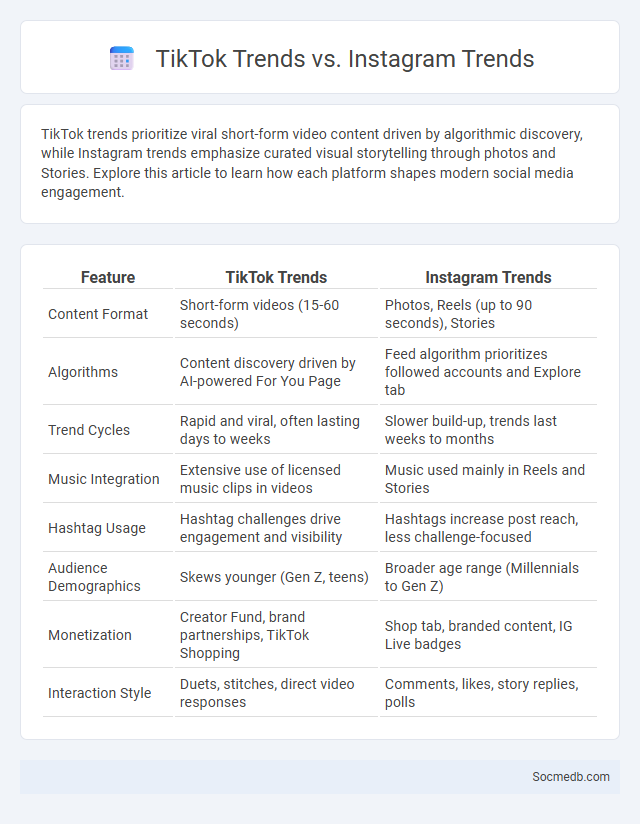
Photo illustration: TikTok Trends vs Instagram Trends
TikTok trends prioritize viral short-form video content driven by algorithmic discovery, while Instagram trends emphasize curated visual storytelling through photos and Stories. Explore this article to learn how each platform shapes modern social media engagement.
Table of Comparison
| Feature | TikTok Trends | Instagram Trends |
|---|---|---|
| Content Format | Short-form videos (15-60 seconds) | Photos, Reels (up to 90 seconds), Stories |
| Algorithms | Content discovery driven by AI-powered For You Page | Feed algorithm prioritizes followed accounts and Explore tab |
| Trend Cycles | Rapid and viral, often lasting days to weeks | Slower build-up, trends last weeks to months |
| Music Integration | Extensive use of licensed music clips in videos | Music used mainly in Reels and Stories |
| Hashtag Usage | Hashtag challenges drive engagement and visibility | Hashtags increase post reach, less challenge-focused |
| Audience Demographics | Skews younger (Gen Z, teens) | Broader age range (Millennials to Gen Z) |
| Monetization | Creator Fund, brand partnerships, TikTok Shopping | Shop tab, branded content, IG Live badges |
| Interaction Style | Duets, stitches, direct video responses | Comments, likes, story replies, polls |
Overview of Social Media Trends
Social media trends in 2024 highlight the rise of short-form video content, with platforms like TikTok and Instagram Reels dominating user engagement and advertising dollars. Increased integration of artificial intelligence enhances personalized content delivery, boosting interaction rates and user retention. Brands prioritize authentic storytelling and influencer collaborations to build trust and drive conversions amid shifting consumer behaviors.
Key Differences: TikTok vs Instagram Trends
TikTok trends are driven primarily by short-form video content featuring viral challenges, music clips, and creative editing tools that encourage rapid user participation and replication. Instagram trends revolve around visually curated images and stories, with a growing emphasis on Reels to compete with TikTok's video format, blending lifestyle aesthetics with influencer marketing. User demographics also differ, as TikTok attracts a younger audience focused on entertainment and spontaneity, while Instagram maintains a broader age range centered on brand engagement and aspirational lifestyle content.
Understanding What Goes Viral
Content that resonates emotionally and taps into trending topics has a higher chance of going viral on social media platforms like Instagram, TikTok, and Twitter. Algorithms prioritize posts with high engagement rates, including likes, shares, comments, and watch time, amplifying their reach exponentially. Influencer collaborations and timely participation in popular challenges or hashtags also significantly boost viral potential.
Trend Lifespan: TikTok vs Instagram
TikTok trends typically have a shorter lifespan, often peaking within days due to rapid content consumption and virality, while Instagram trends tend to last longer, sometimes weeks or months, thanks to curated posts, stories, and reels that encourage sustained engagement. Your brand's marketing strategy should align with TikTok's fast-paced trend cycles for quick bursts of visibility and leverage Instagram's longer trend lifecycle for building lasting audience connections. Understanding these platform-specific trend dynamics enables optimized content timing and maximized social media impact.
How Algorithms Influence Trends
Algorithms analyze vast amounts of user data to identify patterns and preferences, shaping which content becomes viral and trends gain traction. By prioritizing engagement metrics such as likes, shares, and comments, these algorithms amplify content that resonates with Your interests, thereby influencing the visibility of new trends. This data-driven approach ensures that social media trends are not random but strategically curated to maintain user attention and drive platform growth.
Content Formats that Go Viral
Short-form videos dominate social media platforms, with TikTok and Instagram Reels generating the highest engagement rates due to their quick, easily consumable nature. Interactive content like polls, quizzes, and live streams fosters real-time user participation, boosting algorithmic visibility and shareability. Memes and trending challenges leverage humor and relatability, driving viral sharing through widespread audience identification and replication.
Audience Engagement on Each Platform
Audience engagement on social media varies significantly across platforms, with Instagram excelling in visual content interaction and stories, generating high user interaction through likes, comments, and shares. Twitter fosters real-time conversations and trending topic participation, encouraging retweets and replies that amplify content visibility. LinkedIn focuses on professional networking, driving engagement through industry-specific discussions, article shares, and endorsements that enhance credibility and connections.
Influencer Impact on Trends
Influencers shape social media trends by leveraging their large, engaged audiences to promote new products, styles, and ideas rapidly across platforms like Instagram, TikTok, and YouTube. Their content often sparks viral movements, driving consumer behavior and brand marketing strategies worldwide. Understanding how influencers affect trends helps you anticipate market shifts and align your social media strategy for maximum impact.
Cross-Platform Trend Migration
Cross-platform trend migration shapes how social media content gains widespread visibility, as viral topics quickly jump from TikTok to Instagram Reels and Twitter Spaces. Your ability to leverage this dynamic ecosystem depends on understanding platform-specific audience behaviors and adapting content formats accordingly. Monitoring real-time analytics across channels enhances strategy for maximizing engagement and capitalizing on evolving digital trends.
Brands Leveraging Viral Trends
Brands leveraging viral trends on social media can significantly boost engagement and reach by tapping into current popular content. By quickly adapting their messaging and visuals to align with trending hashtags, challenges, or memes, Your brand can connect authentically with a broader audience. This strategic approach increases visibility, drives organic traffic, and enhances brand relevance in fast-evolving digital landscapes.
 socmedb.com
socmedb.com